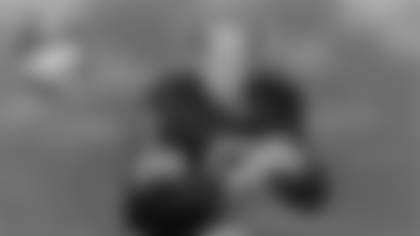John from Green Bay
I recently purchased a 1950 Packers stock certificate signed in 1959 by John Torinus and Dominic Olejniczak as secretary and president. Who was the secretary of the executive committee in 1959? The stock was issued in 1950. Would there have been any stock issued in 1959?
A few years ago, I spent a month or more going through our corporate records of the 1923, 1935 and 1950 stock sales. Actually, I found the records for the 1923 sale to be more complete than those for the 1935 sale, partly because buyers in the latter sale could choose a stock certificate or advertising space in the Packers' game programs for their $25, and it was difficult to determine at times which choice businesses made. As for the 1950 sale, there were complete records, including two sets of receipt books and typewritten lists of the buyers. There were books of pocket-sized receipts and also large ledgers where the sales were listed. That was in addition to master lists of shareholders. However, in digging through the records, there were discrepancies with what previously had been published in the Green Bay Press-Gazette during the stock drive, in several Packers history books, other publications and even our own media guide for a number of years. What I found was that there were still 468 shares of outstanding stock from the 1935 sale that some writers and perhaps Packers officials had included to boost the total amount of money raised during the 1950 drive. Those 468 shares were worth $11,700. I also found that people pledged to buy stock during the door-to-door drives in 1950 and then didn't follow up and pay for it. That's why for years, it was reported that the Packers raised more than $118,000 in the 1950 sale – I've even seen a number as high as $125,000 – when, in fact, they raised a little more than $104,000 that year. However, in response to your question, no deadline was set for the sale. Thus, an additional 50 shareholders were added to the rolls between 1951 and 1959, which mathematically would have raised an additional $1,250. But, for example, Vince Lombardi received a single share on Oct. 23, 1959. What I don't know is if he had to pay $25 for it or if the Packers simply gifted it to him? Ditto for newly elected board members who hadn't previously purchased shares. That's why our media guide now states the amount collected in the 1950 sale was $104,137.50, which was the amount raised prior to the Jan. 22, 1951, shareholders meeting, according to the minutes of that meeting. (Yes, nine people were allowed to purchase a half-share at $12.50.) For transparency's sake, our former shareholders services manager, had previously researched the same corporate records that I did and arrived at a figure that was $2,550 more than mine, although with a slightly different timeframe, April 10, 1950 through Dec. 19, 1950, which might have been viewed at the time as the unofficial end of the drive. But that was a substantial enough number to raise doubt in my mind about the accuracy of my total. Thus, I conducted a second search of the more than 1,600 receipts, and I believe I found an explanation for all but $50 of the difference. On April 15, 1950, Northern Paper Mills was listed on receipt No. 184 for purchasing 100 shares of stock. On July 9, 1950, the Sullivan-Wallen American Legion Post was credited on receipt No. 1501 for owning 100 shares of stock. But there was a notation on the Sullivan-Wallen receipt that it was actually a transfer of the 100 shares purchased by Northern Paper Mills on April 15. In essence, one sale was recorded twice in the receipt books. (Northern still owned $500 worth of stock from the 1935 sale.) In the end, after taking that into account, two searches by different people arrived at figures within $50 of each other. That's why I feel confident the $104,137.50 figure is accurate. John Torinus was elected secretary-treasurer of the Packers on March 7, 1955, and continued to serve as secretary until his death in October 1985. Fred Trowbridge replaced him as treasurer in 1959.
Cesar from Ecuador, South America
What was the date of the first Monday Night Football game in Green Bay?
Oct. 1, 1979. The Packers beat New England, 27-14. ABC started broadcasting weekly Monday night games in 1970, three years into the Packers' nearly quarter-century drought. Thus, they weren't exactly a popular draw. In all, the Packers played in 10 Monday night games before 1979 and only three of those were home games, all played at Milwaukee County Stadium. The reason for not playing in Green Bay was this: The lighting at Lambeau Field was inadequate for a national, nighttime, color telecast. Before the 1979 season, the Packers installed new lights that provided six times the illumination of the old lights.

Jon from New York City
Small corrections. In answering a question about the 1972 Packers, you wrote: "But take nothing away from what was the only Packers team to win a division between Lombardi's last season and Mike Holmgren's fourth season." In 1982, the Packers also won the NFC Central Division title (albeit in a strike year). In answer to a question about the oldest teams in the NFL, you wrote: "Then again, the Packers have been based in the same city longer than any team in the NFL." Both the Packers and the Bears have played in the same city since 1921, although the Bears were still known for that season as the Staleys. Thanks for all your great work.
In 1982, when the strike was settled in November, part of the agreement called for dropping division standings and determining the 16 playoff berths by conference records. Yes, the Packers had the best record (5-3-1) of the five NFC Central teams, but no division champions were recognized. Nor were division standings kept for the remainder of the season. Actually, the Packers played only three games against division opponents – two vs. Detroit, one vs. Minnesota – and they were 1-2. Two games each against Chicago and Tampa Bay were cancelled. As for your second point, I'll grant that probably most people responsible for recording the NFL's history and records, and maybe even most pro football researchers would agree with you. They might also tell me that I'm quibbling over semantics. But from what I've been able to determine, this is another example of revisionist history on pro football's part. Yes, the NFL Record & Fact Book and Total Football, the NFL's official encyclopedia, list the team that won the 1921 league title as the Chicago Staleys. As for the semantics, I wrote "based" in the same city, whereas you wrote "played" in the same city. And I contend there is a difference. Here's why I believe the Staleys were still Decatur's team in 1921. They held their preseason practices there and played their first two games there – a non-league game vs. Waukegan and a league game vs. Rock Island – before playing the rest of their home schedule in Chicago. The Rock Island game drew an estimated 4,000 fans to Staley Field in Decatur; the next week, the Staleys played the Rochester Jeffersons at Cubs Park and drew double that. Obviously, there was more money to be made in Chicago. However, I don't believe the league ever voted to approve a move and the Chicago Tribune, among others, continued to refer to the team as the Staleys of Decatur. So did the Decatur newspapers. Before the APFA's January 1922 meeting, the Decatur Review speculated that the city was about to lose its team to Chicago, but added: "While the Staleys played all their big games in the Cub Park, they were known as Decatur Staleys, a thing which did not sit so well with some of the typical Chicago Boosters." Granted, the Staleys also practiced in Chicago once they started playing their games there. But the Packers also practiced in Chicago for close to a month at the end of the 1921 season because their new recruits were scattered across the Midwest and there weren't enough players living in Green Bay to practice there. This also was during a time when the fledgling league had traveling teams that didn't play games at home, but weren't stripped of their name because of it. There were headline writers in 1921 who used "Chicago Staleys," but in almost every newspaper that I could find that year in other APFA cities, the sportswriters continued to refer to the team as the Decatur Staleys. Here's a sampling: In September 1922, in a preview to the next football season, the Chicago Tribune wrote: "The Chicago Bears, which will be the name of the team that is made up for the greater part of the Decatur Staleys of last fall." When the Packers played the Staleys for the first time on Nov. 27, 1921, George Whitney Calhoun covered the game for the Press-Gazette, and his lead read: "Fighting as only a Green Bay team can fight, the Packers went down to defeat at the hands of the Decatur Staleys by the score of 20-0…" When the Staleys played the Buffalo All-Americans on Dec. 4, 1921, in the game that settled the APFA race that year, the lead in the Buffalo Courier read: "The Staleys, the husky professional football team hailing from Decatur, Ill., but playing their games in Chicago…" Before the first of the two Buffalo-Staleys games in late November, the Buffalo Enquirer's headline read: "All-Americans Off for Chicago; Will Play Staleys." But the first paragraph started: "Buffalo football fans and the members of the All-American football team living in and near Buffalo will board a special car on the Michigan Central railroad tonight at 9 o'clock and start for Chicago, where tomorrow they will take on the Decatur Staleys…" Joe Carr was president of the league and based in Columbus, Ohio. While I don't have access to the Columbus newspapers or any of Carr's files, the Akron (Ohio) Beacon Journal, home to the third team in the APFA race that year, also referred to the eventual champions as the Decatur Staleys as late as the third week of November. Ditto for The Dayton (Ohio) Evening Herald, home of another APFA franchise and only 70 miles from Columbus. It stated in its Oct. 21, 1921 edition that "the Triangles will leave Saturday night for Chicago where they will play the Staleys of Decatur at Cubs Park…" I did a newspapers.com search of the "Chicago Staleys" for the year 1921 and got only 38 hits, including stories with the words "Chicago" and "Staleys," but also "Decatur." I haven't researched this the way I would have if the subject pertained to the Packers and maybe there's a record somewhere that can prove me wrong, but it sure seems like that in 1921 (the only year that counts) almost the entire pro football world considered the Staleys to be Decatur's team.















